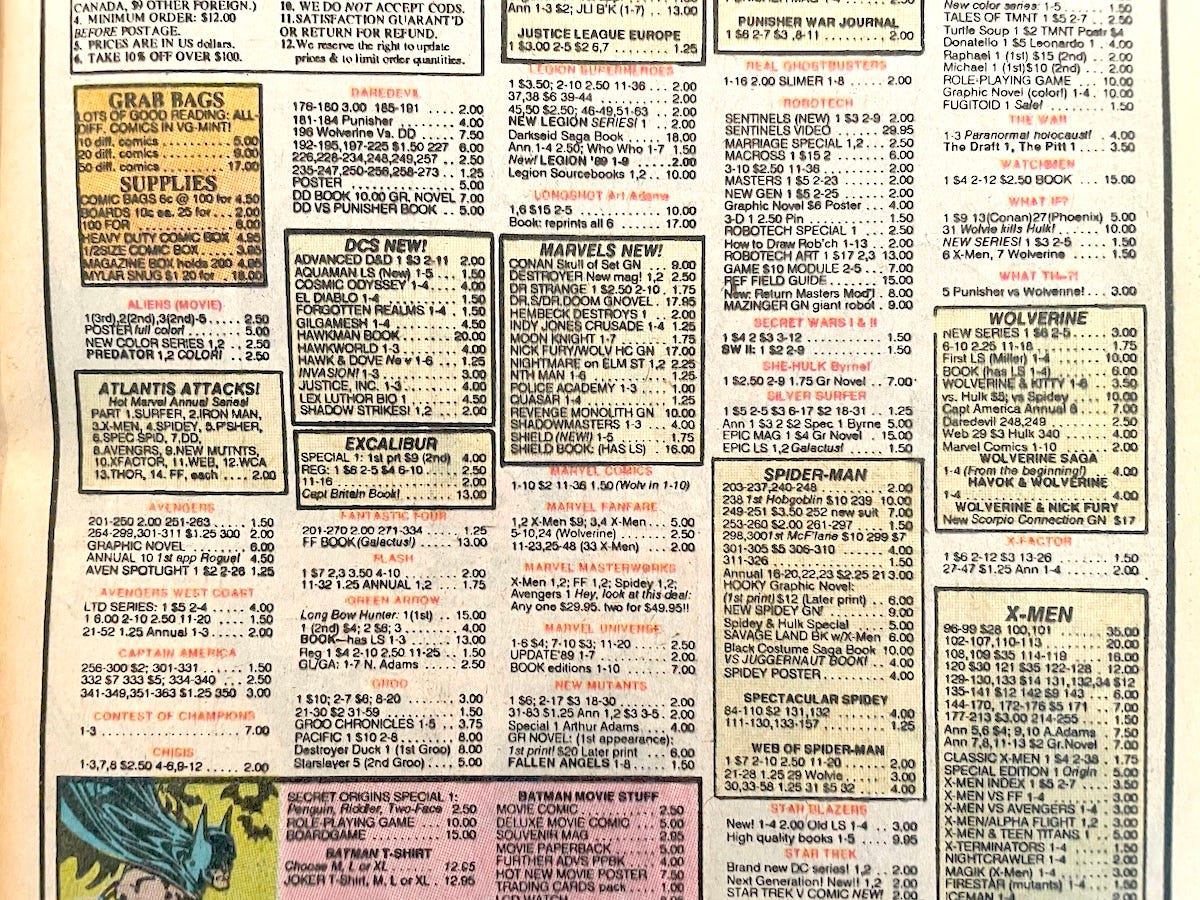
A Model Train, a Poem, a Step Ladder, a Wastebasket
A novel is a model train wrapped around a poem. You decide the particulars of the train and the sights it passes on its track. You fret about the scale at which to create the signage and buildings. Experiment with different materials for track ballast and trees.
Meanwhile you imagine a reader’s emotional and psychological reactions to a poem. You imagine rhythms and imagery that could evoke these emotional and psychological reactions. You turn over shorter and shorter possible versions of this hypothetical poem in your mind. You might even write a poem.
Then you imagine 1) a set of circumstances whereby a person boards the train, and 2) a plan to narrate what follows in a way that manifests the poem and evokes the intended reactions.
You need a step ladder to climb frequently for observing how well all of this is working, and a sufficiently large wastebasket1 for whatever isn’t.
Night Committee album release potential venue poll
Night Committee’s third album is recorded, mixed, and mastered. We’re in the process of nailing down art, design, and record pressing. Sometime in the middle-distance future, we will have a release show. Tell us where to book it.

INTERIONAUTS VOL. 3 #31 — NOVEMBER 1989
[TITLE PAGE]
MONA SEE was lost, confused, and heading nowhere fast—until she discovered the secret of the UNCOUNTABLE HOLLOW EARTHS beneath our feet! Now she leads the strange adventurers known as…THE INTERIONAUTS!
Previously in INTERIONAUTS…
The mysterious DIMENSION X BOMBARDIER, in a desperate bid to escape the fearsome JELLYFISH ASTEROID BLOOM, was about to pilot his eldritch 1943 LANCASTER BOMBER through a hole in the STRONG NUCLEAR FORCE into a micronized ANTI-UNIVERSE…when the unexpected voice of ORLA STRONGARM crackled from his radio. But Orla fell to her death into the MAGMA SEA beneath the unfathomable COUNTERPEAK nearly five years ago! What could this mean?
Meanwhile, after ace reporter GRETCHEN STEIN came dangerously close to discovering the secret ELEVATOR ROOM, the INTERIONAUTS were forced to relocate STATION MAIN once again. Where will they discover themselves this time?
[CREDITS]
[PAGE 1]
Splash page: strange alpine COASTLINE: tall pine trees, receding cliffs, above a still ocean FJORD. Towering mountains in the background. A waterfall between rock pinnacles in the middle distance. Muted colours, painterly, calm.
[PAGE 2]
Quick succession of tighter panels: A FLASH OF LIGHT spinning off STRANGE COLOURS overwhelms the scene. Reduce visuals to reverse negative-space silhouettes.
Big half page panel: The lights fade and now a BUILDING sits on one of the waterfall clifftops, hundreds of feet above the fjord.
[PAGE 3]
We zoom in over several panels and see that the building is a TRUCK STOP: a few gas pumps, a glass-fronted diner, a garage. A large sign that says: STATION MAIN. A tow truck, an old boat of a Chevy Impala, a big half-ton pick up with a snowplow on the front.
MONA SEE comes out of the truckstop holding a mug of coffee, wearing sunglasses and a ball cap. Close up to her face when she pulls the sunglasses off with her free hand to show her BLANK WHITE EYES and looks out across the landscape.
MONA SEE: Well this isn’t going to work…
Mid-issue poll
Re-type and read The Lorax out loud
If all of that further-up-the-page business about trains and poems applies, one of the key skills to practice is controlling the rhythm of the train trip. That is, things are going to happen, in a sentence and in a story, and a writer has to pace and balance those things.
This exercise replicates the experience of reading a well-crafted, complex, rhyming children’s story out loud, over and over: gradually gaining understanding of how the rhythm and voice work, then mastery over forming that rhythm and voice with your mouth and lungs, and then getting insight into how the rhythm and voice are pacing the narrative and cueing the reader’s attention. It’s also really fun, regardless of whether kids are around or not.
So first we’re going to re-type it to feel the text under our fingers, and then we’re going to read it out loud over and over again to feel it in our mouths, and this is going to show us things about how the story is organized.
Part one: re-type
Day 1
Get a copy of The Lorax by Dr. Seuss. The Grinch should also work but I haven’t tried it for this exercise. You need a single narrative, so something like One Fish Two Fish Red Fish Blue Fish will not work.2
Open a word processor. Go to the preferences and turn off auto spelling correction, grammar recommendations, automatic capitalization, and any other intrusive or invasive features that will interfere with what you type.
Do not listen to music, or people talking, or anything else that will put language or rhythm into your brain.
Open The Lorax and start typing the story word for word. Duplicate all punctuation and typography (indentations, italics, capitalizations) as nearly as you can manage. Correct your own spelling as you go and duplicate all Seuss words faithfully.
Aside from pauses to drink or go to the bathroom, transcribe the entire book, from beginning to end, in one sitting. The Lorax is 1,810 words, so depending on how fast you type this may take an hour to ninety minutes. Sitting and typing for ninety minutes straight is really, really hard. Part of this is building endurance and focus.
Give yourself a ten minute break. Don’t talk to anyone. Go to the bathroom, drink something, walk around your home. Go outside and walk around if you feel confident that you can avoid distractions. Remember: no music. Don’t let any external rhythms impose themselves on you.
Come back to your word processor. Use page breaks to split up the text into as many roughly equal chapters as seem right. Three? Nine? Whatever the text tells you. Two is too few and 42 is too many. Do this quickly without thinking too much. Don’t go by word count or use a calculator.
At the top of each of these pages write a single sentence explaining to yourself what happens in that chapter.
Do something else. If it’s late, go to bed.
Part two: read out loud
Day 2
Print out your transcription of The Lorax. In an empty room where you won’t be disturbed for a half an hour, read your transcription out loud, all the way through, once. Do not speak your chapter titles, but take a two-breath pause as you hit each one. As you read, pay attention to:
The ease and difficulty of different passages—the parts that you trip over and the parts that come easily.
The difference in rhythm between those parts.
Day 3
Go back to your reading-out-loud room. While you read this time pay attention to:
Parts that were hard that practice and familiarity have made easier.
How those parts sound now that you can manage them.
How specific word choices contribute to the rhythm. Watch for modifiers, the lack of modifiers, and the invented words or sound-constructions that Seuss uses in their place.3
Day 4
You should have a fairly good command of reading the thing well, with an even flow, and not tripping over things. Now instead of paying attention to how easy or difficult it is to say, think about:
The distinct rhythmic patterns in the text — how the stanzas are shaped, where the stresses happen, the rhyme scheme.
When these occur.
When they repeat.
Day 5
Start paying attention to the narrative:
The transitions between the framing narrator and the Once-ler’s narration.
The decisions that the Once-ler makes.
Where these decisions and transitions fall within your initial section divisions.
Consider the way that you’ve delivering the last stanzas—everything past UNLESS—now that you’ve got a feel for everything. Listen for your tone on the word “may” in that last line.
Day 6
Go back to your transcript document. Do your initial chapter divisions and single sentence summaries still seem right? Make adjustments to them as needed, thinking about:
The distinct rhythm patterns you noticed on Day 4.
The narrative transitions and events you noticed on Day 5.
Read this final version out loud. This is your dress rehearsal. Are you happy with how it sounds? Make your final changes.
Day 7
Read The Lorax out loud to someone you trust and love. This can just be yourself, alone in your reading-out-loud room.
Sufficiently large = the size of the entire thing if necessary. Throwing out a hundred pages that don’t work is always better than writing another hundred pages that still don’t work.
But don’t deprive yourself the joy of saying
The ink he likes to drink is pink. He likes to wink and drink pink ink.
out loud every now and then.
He also does this by inventing nouns whose texture and sonic quality do the work a modifier might do. Then he stacks these up to build steam, maintain pattern, and place emphasis:
Then he hides what you paid him
away in his Snuvv,
his secret strange hole
in his gruvvulous glove.
Then he grunts, “I will call you by Whisper-ma-Phone,
for the secrets I tell are for your ears alone.”





